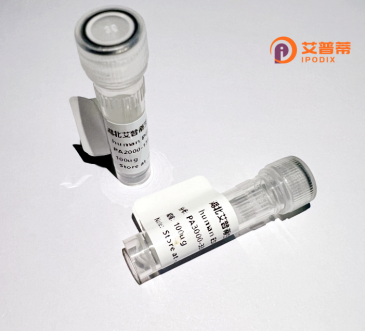
| 纯度 | >90%SDS-PAGE. |
| 种属 | Human |
| 靶点 | ZNF707 |
| Uniprot No | Q96C28 |
| 内毒素 | < 0.01EU/μg |
| 表达宿主 | E.coli |
| 表达区间 | 1-369 aa |
| 活性数据 | MAQEPVTFRDVAIYFSREEWACLEPSQRALYRDVMLDNFSSVAALGFCSPRPDLVSRLEQWEEPWVEDRERPEFQAVQRGPRPGARKSADPKRHCDHPAWAHKKTHVRRERAREGSSFRKGFRLDTDDGQLPRAAPERTDAKPTAFPCQVLTQRCGRRPGRRERRKQRAVELSFICGTCGKALSCHSRLLAHQTVHTGTKAFECPECGQTFRWASNLQRHQKNHTREKPFCCEACGQAFSLKDRLAQHRKVHTEHRPYSCGDCGKAFKQKSNLLRHQLVHTGERPFYCADCGKAFRTKENLSHHQRVHSGEKPYTCAECGKSFRWPKGFSIHRRLHLTKRFYECGHCGKGFRHLGFFTRHQRTHRHGEV |
| 分子量 | 69.3 kDa |
| 蛋白标签 | GST-tag at N-terminal |
| 缓冲液 | PBS, pH7.4, containing 0.01% SKL, 1mM DTT, 5% Trehalose and Proclin300. |
| 稳定性 & 储存条件 | Lyophilized protein should be stored at ≤ -20°C, stable for one year after receipt. Reconstituted protein solution can be stored at 2-8°C for 2-7 days. Aliquots of reconstituted samples are stable at ≤ -20°C for 3 months. |
| 复溶 | Always centrifuge tubes before opening.Do not mix by vortex or pipetting. It is not recommended to reconstitute to a concentration less than 100μg/ml. Dissolve the lyophilized protein in distilled water. Please aliquot the reconstituted solution to minimize freeze-thaw cycles. |
以下是关于重组人ZNF707蛋白的3篇代表性文献的简要概括:
1. **文献名称**:*ZNF707 functions as a tumor suppressor in ovarian cancer by regulating HDAC1/c-MYC signaling*
**作者**:Li et al. (2022)
**摘要**:该研究发现ZNF707在卵巢癌中表达降低,重组ZNF707蛋白的过表达可抑制癌细胞增殖,并揭示其通过结合并抑制HDAC1/c-MYC信号通路发挥抑癌作用。
2. **文献名称**:*Structural insights into the DNA-binding mechanism of ZNF707 and its role in epigenetic silencing*
**作者**:Wang et al. (2021)
**摘要**:通过体外重组ZNF707蛋白的晶体结构解析,揭示了其锌指结构域特异性识别甲基化DNA的分子机制,为ZNF707参与表观遗传沉默提供结构依据。
3. **文献名称**:*ZNF707 modulates human germ cell development through interaction with the NuRD complex*
**作者**:Smith et al. (2020)
**摘要**:利用重组ZNF707蛋白进行互作实验,证实其与NuRD复合体结合,调控生殖细胞分化过程中的基因表达,提示其在早期发育中的潜在作用。
以上文献均涉及重组ZNF707蛋白的功能或机制研究,覆盖肿瘤、表观遗传和发育生物学领域。具体文献需通过PubMed或Web of Science根据标题检索全文。
Recombinant human ZNF707 protein is a zinc finger (ZNF) family member encoded by the ZNF707 gene, located on chromosome 8q21.13. Zinc finger proteins are characterized by conserved cysteine and histidine residues that form structural motifs facilitating DNA, RNA, or protein interactions. ZNF707 contains multiple C2H2-type zinc finger domains, suggesting roles in transcriptional regulation, chromatin remodeling, or epigenetic modulation. While its precise biological functions remain under investigation, ZNF707 is hypothesized to participate in gene silencing, possibly through recruiting chromatin-modifying complexes like Polycomb repressors or DNA methyltransferases.
Studies indicate ZNF707 may influence embryonic development and cellular differentiation. Recent research links ZNF707 dysregulation to diseases, including cancer, where aberrant expression correlates with tumor progression, metastasis, or drug resistance. For example, it may suppress tumor suppressors or activate oncogenic pathways in certain contexts.
The recombinant form of ZNF707 is typically produced in Escherichia coli or mammalian expression systems for in vitro studies. Its applications include elucidating molecular interactions, screening for binding partners, and exploring therapeutic targets. Further research is needed to clarify its mechanisms and validate its role in health and disease, making recombinant ZNF707 a valuable tool for advancing functional genomics and precision medicine.
×